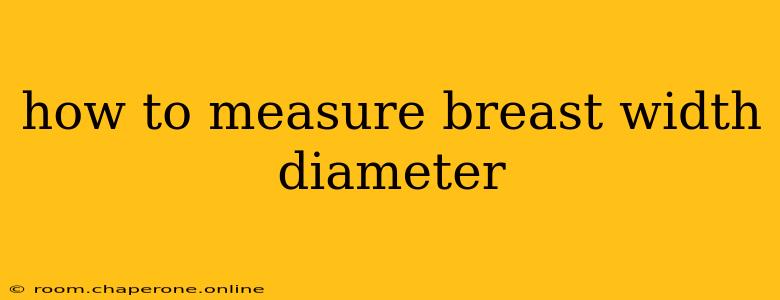Measuring breast width, also known as breast diameter, isn't a standard medical measurement like bra size. However, understanding how to accurately measure this can be helpful for various reasons, including:
- Tracking changes: Monitoring breast width over time can be useful for individuals tracking potential changes related to weight fluctuations, hormonal changes, or medical conditions.
- Clothing fit: Knowing your breast width can help ensure proper fit with clothing, particularly swimwear and certain tops.
- Medical consultations: While not a routine measurement, providing this information to your doctor might be helpful in certain medical contexts.
This guide will explain how to accurately measure your breast width, emphasizing the importance of consistency for reliable results.
What You'll Need:
- A flexible measuring tape: A soft measuring tape, ideally one used for sewing or body measurements, will provide the most accurate results. Avoid rigid measuring tapes that might distort the measurement.
- A mirror: A mirror will help ensure accurate placement of the measuring tape.
- A comfortable, supportive bra: Wearing a supportive bra will provide a consistent base for the measurement and prevent sagging that could affect the result.
Step-by-Step Measurement Guide:
-
Preparation: Stand in front of a mirror, wearing a supportive bra. Ensure your posture is upright and relaxed; slouching can impact the measurement.
-
Finding the widest point: Locate the widest point across your breasts. This is usually found at the fullest part of your bust, horizontally across your chest.
-
Placement of the tape measure: Place the measuring tape horizontally across your chest, ensuring it passes evenly over the widest point of both breasts. The tape should sit comfortably but not too tightly.
-
Taking the measurement: Carefully read the measurement where the ends of the tape meet. Record this number—this is your breast width.
-
Repeat for accuracy: Repeat steps 3 and 4 at least two more times, ensuring the tape measure is positioned consistently each time. Average your measurements to get a more accurate result.
Important Considerations:
- Consistency is key: The most important aspect is maintaining consistent positioning of the measuring tape for each measurement. Variations in placement will greatly influence the result.
- Relaxed posture: Ensure a relaxed, upright posture to avoid artificially increasing or decreasing the measurement.
- Bra support: The type of bra worn can influence the measurement. Using the same bra each time will help minimize this variable.
- Body changes: Be aware that breast width can naturally fluctuate due to weight changes, hormonal cycles, and other factors. Consistent measurement over time will allow you to track these changes.
- This is not a medical diagnosis: This measurement should not be used for self-diagnosis or to replace professional medical advice. Consult a healthcare professional for any concerns about breast health.
Beyond the Measurement:
While this guide provides a clear method for measuring breast width, remember that overall breast health is far more important than a single measurement. Regular self-breast exams and routine mammograms are vital for early detection of potential issues. Consult your healthcare provider for advice tailored to your individual needs and risk factors.
This comprehensive guide aims to provide you with the knowledge and steps needed to accurately measure your breast width. Remember consistency and accurate technique are crucial for reliable results. Always prioritize your overall health and seek professional medical advice when needed.

